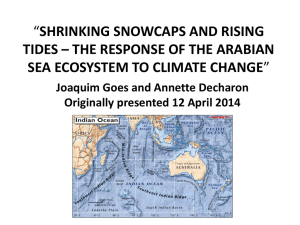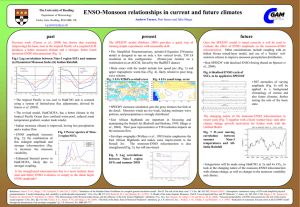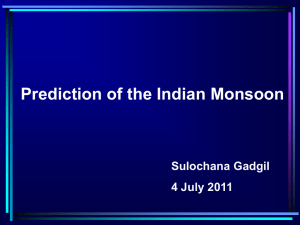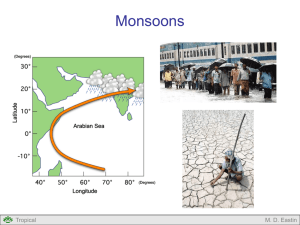Monsoons
advertisement
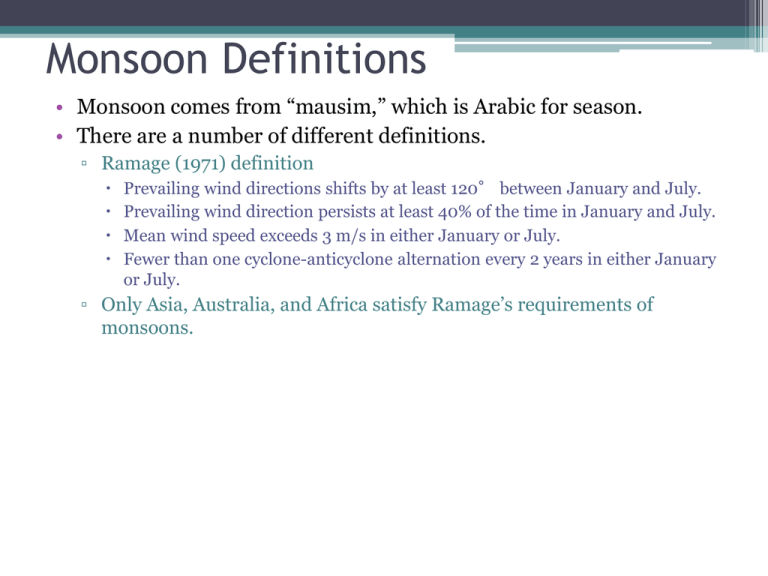
Monsoon Definitions • Monsoon comes from “mausim,” which is Arabic for season. • There are a number of different definitions. ▫ Ramage (1971) definition Prevailing wind directions shifts by at least 120° between January and July. Prevailing wind direction persists at least 40% of the time in January and July. Mean wind speed exceeds 3 m/s in either January or July. Fewer than one cyclone-anticyclone alternation every 2 years in either January or July. ▫ Only Asia, Australia, and Africa satisfy Ramage’s requirements of monsoons. Monsoon Definitions • Monsoon comes from “mausim,” which is Arabic for season. • There are a number of different definitions. ▫ Ramage (1971) definition Prevailing wind directions shifts by at least 120° between January and July. Prevailing wind direction persists at least 40% of the time in January and July. Mean wind speed exceeds 3 m/s in either January or July. Fewer than one cyclone-anticyclone alternation every 2 years in either January or July. ▫ Only Asia, Australia, and Africa satisfy Ramage’s requirements of monsoons. ▫ A more general definition is probably better. One commonly used: Wind must reverse in direction between summer and winter. Summer season must be very wet, and winter season very dry. ▫ Using this definition, North America also experiences a monsoon (in the Southwest U. S. and Northern Mexico.) • Using this general definition, over ½ of the tropics (hence ¼ of entire globe) experience a monsoon climate. Find the Monsoon • • Mean winds at 925 hPa for northern winter (January–February; upper panel) and northern summer (July–August; lower panel) at the height of the monsoon season (units: m s−1). (Data source: Reanalyses from European Centre for Medium Range Weather Forecasts for 1979–93.) From Encyclopedia of Atmospheric Sciences, Monsoons/Overview: Slingo, J Copyright © 2002 Elsevier Science Ltd. Find the Monsoon • • Mean precipitation distributions for northern winter (January–February; upper panel) and northern summer (July– August; lower panel) at the height of the monsoon season (units: mm day−1). (Data source: Global Precipitation Climatology Project.) From Encyclopedia of Atmospheric Sciences, Monsoons/Overview: Slingo, J Copyright © 2002 Elsevier Science Ltd. (a): July NET: northeast tradewinds SET: southeast tradewinds EAM: East Asia Monsoon ISWM: Indian southwest monsoon WAfm: West African monsoon NAmSM: N. American summer monsoon (b) January: NEWM: northeast winter monsoon ANWM: Australian northwest monsoon NAmWM: N. American winter monsoon AfWM: African winter* monsoon *This crosses the equator, but is mostly south of it; of course, it is actually summer there. © 1987 John Wiley & Sons, from Monsoons, Fein and Stephens, Ed., Peter J. Webster: The Elementary Monsoon. Normal Onset Dates • Eurasian Snow Cover has impact From: Indian monsoon. (2010). In Encyclopædia Britannica. Retrieved November 09, 2010, from Encyclopædia Britannica Online: http://www.britannica.com/EBchecked/topic/285795/Indian-monsoon Driving mechanisms • Differential heating of land and ocean • Moist processes DIFFERENTIAL HEATING OF LAND AND OCEAN • The specific heat of water is much larger than that of dry soil. • Effective heat capacity difference is even larger, because mass of ocean is much larger. • Only the upper most few centimeters of land are heated, due to slow molecular transfer of heat vertically. • In oceans, heat is effectively mixed downward tens of meters via turbulent mixing. • The difference in heat capacities, rather than specific heats themselves, is most important. • Moist soil has higher specific heat than dry soil. ▫ Saturated soil behaves more like “ocean” than land. • Differential heating sets up a horizontal pressure gradient (similar to land/sea breeze only on much larger scale.) Issues with differential heating argument Simpson, G., 1921: The south-west monsoon. Q. J. R. Meteorol. Soc., 199, 150-73. “I believe very few educated people would have any difficulties in giving an answer to the question—what is the cause of the monsoon? They would refer to the high temperature over the land compared with that over the surrounding seas; would speak of ascending currents of air causing an indraft of sea-air towards the interior of the country. “It is only when one points out that India is much hotter in May before the monsoon sets in than in July when it is at its heights—or draws attention to the fact that the hottest part of India—the northwest gets no rain at all during the monsoon—or shows by statistics that the average temperature is much greater in years of bad rains than in years of good rains, that they begin to doubt whether they know the real cause of the monsoon.” • • Surface temperatures for early austral summer (November–December; upper panel) and boreal summer (May–June; lower panel) at the onset of the monsoon (units: °C). (Data source: Reanalyses from European Centre for Medium Range Weather Forecasts for 1979–93.) From Encyclopedia of Atmospheric Sciences, Monsoons/Overview: Slingo, J Copyright © 2002 Elsevier Science Ltd. ROLE OF MOIST PROCESSES • Differential heating is not enough to explain the strength and extent of monsoon circulations. • Moisture acts as “stored energy” through latent heat release. • Evaporation occurs over the oceans, and then moisture is transported over the land, where it is released through condensation. • This essentially “focuses” the effects of the solar heating collected over the ocean onto the land areas. • This process is often referred to as the “solar collector.” • Latent heating results in a more intense monsoon flow, and also a vertically deeper monsoon flow. ▫ A moist monsoon has a depth on the order of the troposphere. ▫ A dry monsoon is much shallower, extending only to the midtroposphere. • Moisture also changes the character of the heating of the land. ▫ Moist land acts more like ocean. ▫ If land is dry, rising motion will occur closer to the coast, since the land will be very warm. ▫ As land becomes wet from precipitation, the rising motion will move inland over drier land. ▫ Precipitation will progress inland, allowing coastal area to dry out. Cycle will then repeat itself. ▫ This is one factor in monsoon variability and monsoon “breaks.” LAND/OCEAN GEOMETRY • Latitude and orientation of land masses effect monsoon circulation, as shown in figure, in which grey areas are land. • Areas on or near Equator do not experience much rotation. • Uniform surface (either all land or all water) result more in tradewind trough ITCZ, and not monsoon (e.g., Central Pacific Ocean). • Western boundary results in atmospheric jet (e.g., East African Lowlevel Jet). After “Physics of Monsoons: The Current View,” J.L. Young, in Monsoons (Fein, ed), modified by A. DeCaria Monsoon Variability • Monsoon Depressions (July/August) ▫ Some develop into full TCs • Onset Vortex (Arabian Sea) • Active vs. Breaks ▫ 5-7 Days on average Monsoon Depressions • Form in extension of monsoon trough into Bay of Bengal • Sometimes MidLevel genesis • Hybrid systems (cold core-ish, need shear) • Big rain makers, SW Quadrant Fig. from P.K. Das, Ch. 17 of Fein and Stephens, © 1987 John Wiley & Sons




